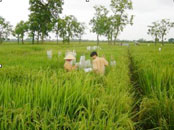After introducing the first hybrid rice variety branded as Vietnamese, Viet Lai 20, which won a scientific and technological award in 2005, scientists from the Rice Research Institute (Vietnam National University of Agriculture I) have successfully created a new hybrid rice variety named “Viet Lai 24”. This variety boasts high yield, can be cultivated in nutrient-poor soils, and has resistance to leaf blight disease.
 |
(Photo: VTV) |
Currently, in the experimental garden of the Rice Research Institute, the seedlings of the hybrid rice variety “Viet Lai 24” are thriving. This is the result of a long research process by scientists from the “Rice Research Institute – Vietnam National University of Agriculture 1”. Through experimental sites representing various ecological regions such as Thai Nguyen, Hanoi, and Ha Nam, the “Viet Lai 24” variety has shown promising results, creating new prospects for rice seed production in our country.
To create hybrid rice varieties, experiments were conducted on gene pool groups, crossing different varieties; Culturing bacteria that cause leaf blight for experimentation and molecular assessment; Subsequently, fertilizer tests were conducted for each type to fully exploit the potential of the combinations; Density, spacing, number of seedlings, and clumps were also experimented with to create a rice population that achieves the highest yield while minimizing pests in the fields.
Field test results indicate that “Viet Lai 24” has a growth duration of 120 days, with short and sturdy plants. This rice variety has also been supplemented with the Xa21 gene from a wild rice variety, which helps combat leaf blight disease and improves drought resistance, making it suitable for cultivation in poor, degraded lands. Notably, the quality of rice from “Viet Lai 24” is evaluated as good, with no chalkiness.
Compared to all existing hybrid rice varieties in Vietnam, “Viet Lai 24” has the shortest growth duration, about 15-20 days less than imported hybrid varieties, making it highly suitable for late spring sowing and early season planting, allowing farmers to effectively manage their winter crop schedule. The product has been granted a patent by the Intellectual Property Office.
Although the “Viet Lai 24” variety still has limitations, such as not being resistant to all strains of the bacteria causing leaf blight across different regions, it has shown an average yield of 8-10 tons per hectare after three years of trials in most ecological zones. It is especially suitable for highland fields due to its good drought resistance and ability to thrive in nutrient-poor soils. With these results, it is hoped that this hybrid rice variety will contribute to the diversification of short-duration rice varieties, aid in the restructuring of crop production, and help our agricultural sector gradually become self-sufficient in hybrid rice seed production, reducing dependence on foreign seed sources.


















































